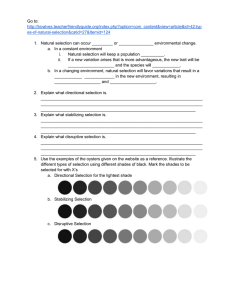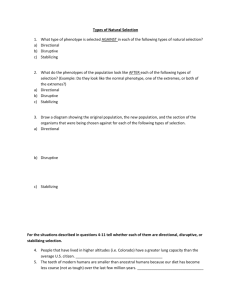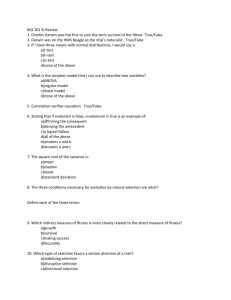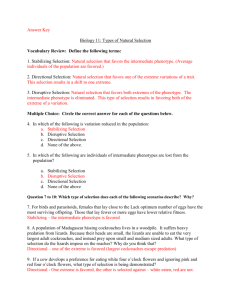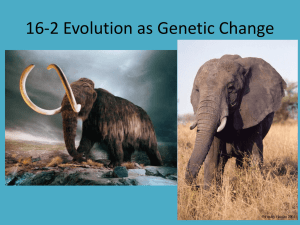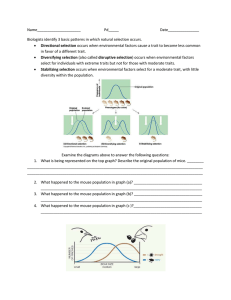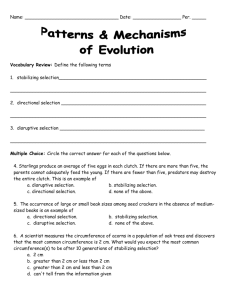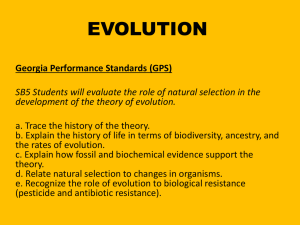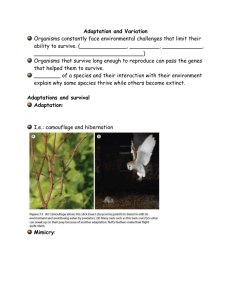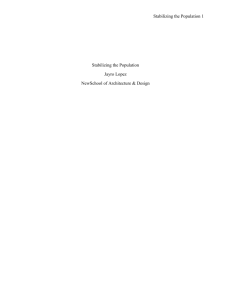Name Evolution – Chapter 16, sections 1 and 2 What are the
advertisement
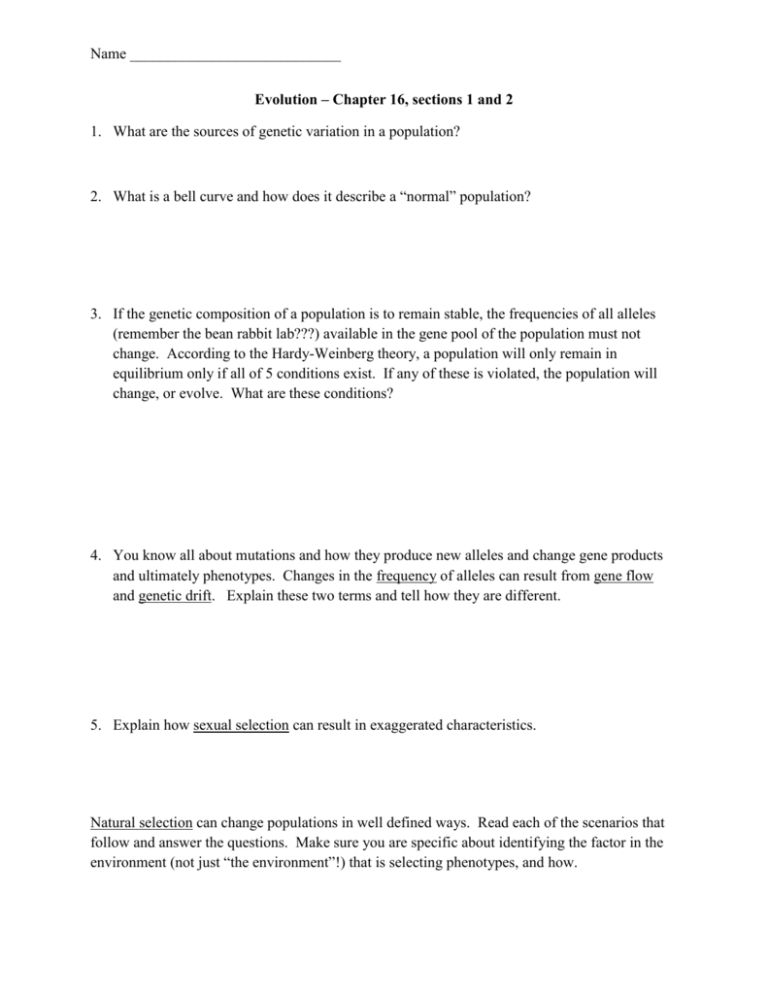
Name ____________________________ Evolution – Chapter 16, sections 1 and 2 1. What are the sources of genetic variation in a population? 2. What is a bell curve and how does it describe a “normal” population? 3. If the genetic composition of a population is to remain stable, the frequencies of all alleles (remember the bean rabbit lab???) available in the gene pool of the population must not change. According to the Hardy-Weinberg theory, a population will only remain in equilibrium only if all of 5 conditions exist. If any of these is violated, the population will change, or evolve. What are these conditions? 4. You know all about mutations and how they produce new alleles and change gene products and ultimately phenotypes. Changes in the frequency of alleles can result from gene flow and genetic drift. Explain these two terms and tell how they are different. 5. Explain how sexual selection can result in exaggerated characteristics. Natural selection can change populations in well defined ways. Read each of the scenarios that follow and answer the questions. Make sure you are specific about identifying the factor in the environment (not just “the environment”!) that is selecting phenotypes, and how. Trends in Natural Selection There are three basic types of natural selection: directional selection favoring an extreme phenotype; stabilizing selection favoring a phenotype with characteristics intermediate to an extreme phenotype (i.e., normalizing selection); and disruptive selection that favors extreme phenotypes over intermediate genotypes. Scenario 1 Many species of moths in the British Isles began to become darker in color in the 19th century. The best-studied example is the peppered moth, Biston betularia. The moth gets its name from the scattered dark markings on its wings and body. In 1849, a coal-black mutant was found near Manchester, England. Within a century, this black form had increased to 90% of the population in this region. The moth flies at night and rests by day on tree trunks. In areas far from industrial activity, the trunks of trees are encrusted with lichens. As the photos show, the light form (circled in red) is practically invisible against this background. In areas where air pollution is severe, the combination of toxic gases and soot has killed the lichens and blackened the trunks. Against such a background, the light form stands out sharply. The moth is preyed upon by birds that pluck it from its resting place by day. In polluted woods, the dark form has a much better chance of surviving undetected. When the English geneticist H. B. D. Kettlewell (who supplied the photos) released moths of both types in the woods, he observed that birds did, indeed, eat a much higher fraction of the light moths he released than of the dark. Since pollution abatement programs were put in place after World War II, the light form has been making a comeback in the Liverpool and Manchester areas. A. Is this is an example of Directional, Stabilizing or Disruptive Selection? B. What is (are) the selective forces acting on the organism? C. Are these forces (which you identified) biotic or abiotic components of the environment? 2 D. With humans involved, is this natural or artificial selection? JUSTIFY! E. The reappearance of the light colored moths is mentioned. Suppose the pollution abatement program works in some areas but not in others, how might a disruptive pattern be evident in regions that contain both dark and light trees? Scenario 2 The residues ("tailings") of mines often contain such high concentrations of toxic metals (e.g., copper, lead) that most plants are unable to grow on them. However, some hardy species (e.g. certain grasses) are able to spread from the surrounding uncontaminated soil onto such waste heaps. These plants develop resistance to the toxic metals while their ability to grow on uncontaminated soil decreases. Because grasses are wind pollinated, breeding between the resistant and nonresistant populations goes on. But over time, despite the cross pollination higher death rates are observed on the less resistant plants growing on contaminated soil as well as higher death rates with the more resistant plants growing on uncontaminated soil. After a period of time it is observed that there are two subpopulations with the extreme manifestations of this trait. A. Is this is an example of Directional, Stabilizing or Disruptive Selection? B. What is (are) the selective forces acting on the organism? C. Are these factors biotic or abiotic? D. With humans involved is this an example of natural or artificial selection? JUSTIFY! Scenario 3 In one study, the birth weights of nearly 7000 human female babies were recorded. After one month, survival of these babies was determined as a function of birth weight. The results showed that the overall survival was 95.9%. Babies which were born less than 4.5 lbs had 41.4% survival 3 rate. Babies born in the 7.5 -8.5 lb range had 98.5% survival while babies greater than 10.0 lb had a 90.5% survival rate. A. Is this is an example of Directional, Stabilizing or Disruptive Selection? B. What is (are) the selective forces acting on the organism? C. With the advent of modern medical technologies and procedures, how might those babies at the “upper end” (those with heavier birth weights) may have a higher survival rate when compared to those earlier in human history? D. With humans involved is this an example of natural or artificial selection? JUSTIFY! Scenario 4 Soon after the discovery of antibiotics, bacteria appeared that were resistant to these drugs. Scientists now know that the genes for antibiotic resistance are carried on small circular pieces of DNA called plasmids which can be transferred from one bacterial cell to another in a process known as conjugation. Over the past century we have observed the emergence of several different resistant strains of bacteria that were historically easily treatable using antibiotics. A. Is this an example of Directional, Stabilizing or Disruptive Selection? B. Did the exposure to antibiotics induce the mutation for resistance? C. With humans involved is this an example of natural or artificial selection? JUSTIFY! 4 D. Today scientists are recommending that medical practitioners limit the use of prescribed antibiotics for minor issues where they may not be necessary. How would this change the selection pattern? Scenario 5 Domesticated dogs are descendents of wild wolves. Today we see a wide variety of dog breeds, each with their own unique physical traits. A. Looking at all the different breeds of dogs, what pattern of selection is evident when comparing a wolf to a pug? B. Why do we consider Great Danes, Pugs, Poodles to be “breeds” and not individual species? C. Is this natural or artificial selection? 5 D. Suppose all humans were to vanish from the earth, what selective pattern would you predict for all the different breeds of dog? (think about which phenotype would be most advantageous). E. What selective forces might dictate this pattern? 6
